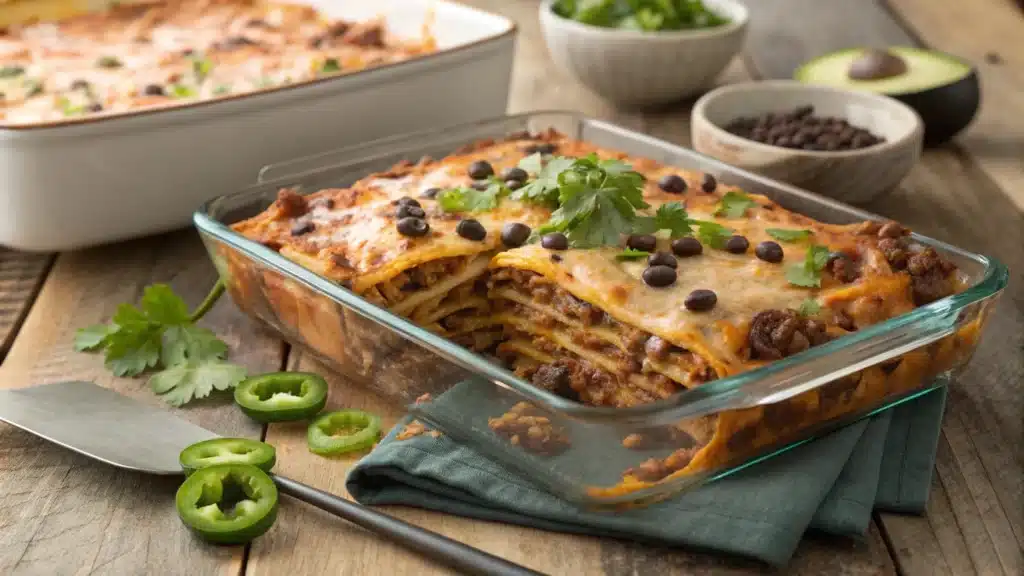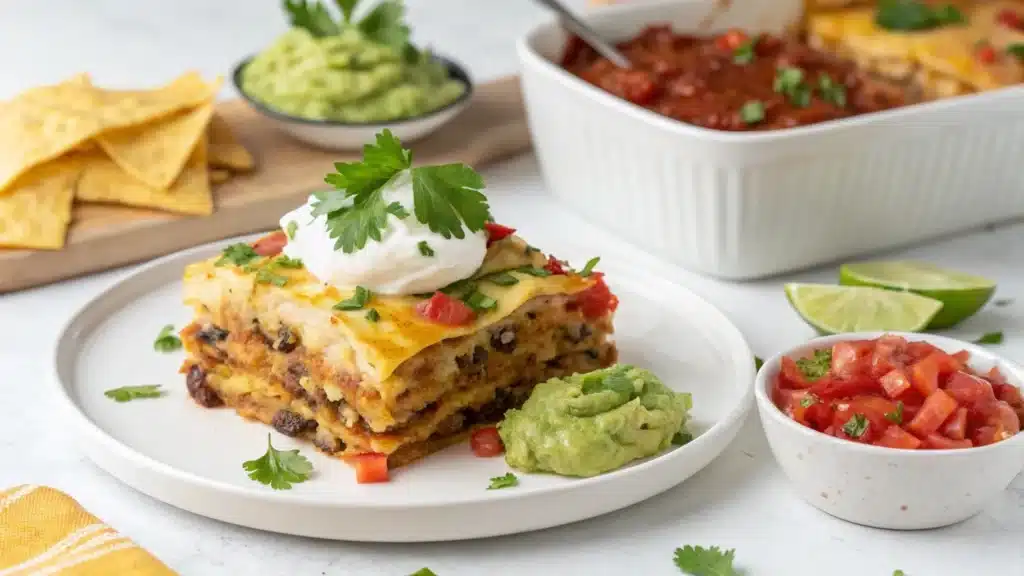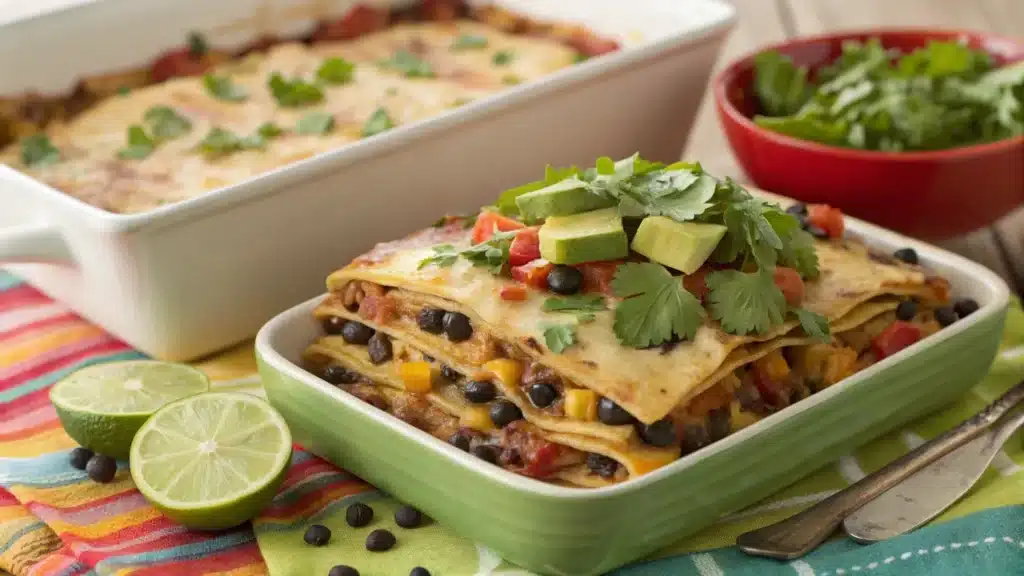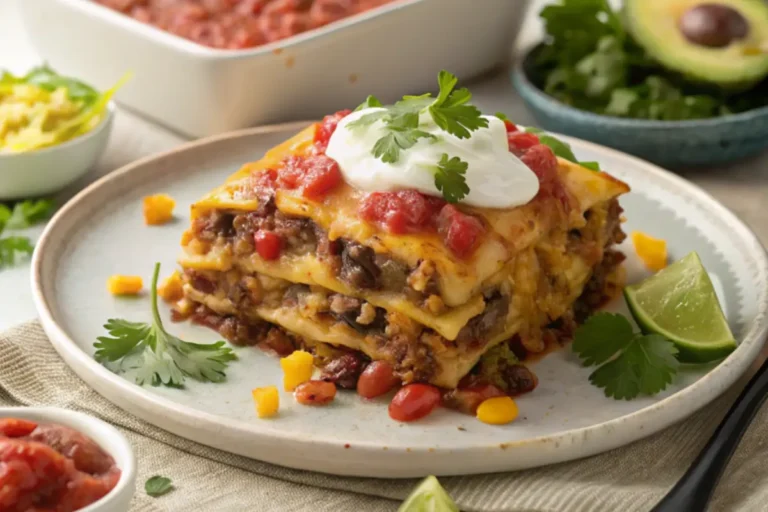What Is Mexican Lasagna Made Of?
This question captures the essence of a dish that puts a flavorful twist on traditional Italian lasagna. Mexican lasagna stands out with its layers of tortillas, seasoned meats, beans, and cheeses, blending Mexican and Italian flavors. The bold spices and vibrant ingredients make it a favorite for family dinners and potlucks. Unlike classic lasagna with pasta sheets, this version uses soft tortillas, giving it a unique texture and taste. It’s also versatile, offering options for various dietary needs, including vegetarian and gluten-free. This article explains everything you need to know about this crowd-pleasing dish, guiding you through its ingredients and the steps to prepare it perfectly. If you want another twist on the lasagna concept, try Taco Lasagna Recipe.
Table of Contents
Key Ingredients of Mexican Lasagna
Understanding what Mexican lasagna is made of begins with knowing its primary ingredients. This dish is a medley of vibrant and hearty components, each playing a pivotal role in its flavor profile:
- Tortillas: A staple of Mexican cuisine, tortillas serve as the “pasta” layers in this dish.
- Protein: Ground beef, shredded chicken, and black beans are popular.
- Cheese: Cheddar, Monterey Jack, or queso fresco blend adds creamy richness.
- Beans: Black or refried beans bring richness and fiber.
- Vegetables: Diced tomatoes, bell peppers, onions, and corn add texture and vibrant color.
Each ingredient plays a crucial role, and using fresh, high-quality components helps the dish reach its full potential. Adjusting the quantities allows for customization, catering to individual tastes and dietary needs. Suppose you’re looking for another hearty dish. In that case, the Pickle Pie Pizza might be an interesting idea for your next family dinner.
The Role of Tortillas in Mexican Lasagna
Tortillas are a key element in Mexican lasagna’s unique flavor. Unlike lasagna noodles, tortillas offer a soft, flexible texture that soaks up the surrounding flavors. Their mild taste balances the bold spices and rich fillings without overpowering them.
Flour tortillas are popular due to their sturdiness, but corn tortillas offer an authentic Mexican flair. Both options work well, depending on personal taste and dietary restrictions. Layers of tortillas mimic traditional pasta sheets, forming a sturdy yet tender base for the lasagna. Additionally, they hold the sauce and fillings together, ensuring each slice remains intact when served.
Some cooks lightly toast the tortillas before layering, which Improves their flavor and prevents sogginess during baking. This simple step can significantly affect the final dish’s texture and taste.
Meat Options: Ground Beef, Chicken, or Vegetarian
The choice of protein is one of the most flexible elements when making Mexican lasagna. Ground beef is a classic option, offering a savory depth that pairs well with spices like cumin and chili powder. Shredded chicken, often cooked with a blend of taco seasoning and salsa provides a lighter yet equally flavorful alternative.
For a vegetarian version, black beans or pinto beans are excellent substitutes. They deliver a hearty texture and protein content while absorbing the spices beautifully. Some recipes also incorporate crumbled tofu or lentils for a creative twist.
You can customize each protein option by adding sautéed onions, garlic, and peppers during cooking. This step improves the meat or meat substitute’s flavor, ensuring it harmonizes with the dish’s other components. Choosing a protein that aligns with your taste and dietary needs confirms that the lasagna is both delicious and satisfying.
Layers of Flavor: How the Layers Come Together
The layering process plays a key role in what makes up Mexican lasagna. Each layer builds upon the other, creating a cohesive dish bursting with flavor and texture. Here’s how the layers typically come together:
- Base Layer: Start with a thin salsa or enchilada sauce coating to prevent sticking.
- Tortilla Layer: Lay down a single layer of tortillas, ensuring complete coverage.
- Protein Layer: Spread cooked ground beef, chicken, or beans evenly.
- Vegetable Layer: Mix diced tomatoes, onions, peppers, and corn.
- Cheese Layer: Sprinkle shredded cheese generously.
- Repeat: Continue layering until you use up all the ingredients, finishing with a tortilla layer topped with cheese
Each layer is vital, contributing distinct flavors and textures that meld together during baking. The key is to distribute ingredients evenly, ensuring every bite offers a balanced taste of the entire dish.

Stovetop Cooking Method
Cooking methods significantly influence the ingredients used in Mexican lasagna. Baking is the most common technique, allowing the flavors to meld together and the cheese to melt into a golden, bubbly topping. Bake the dish at 375°F (190°C) for 25-30 minutes, covering it during the first half to prevent over-browning.
For those seeking a quicker option, stovetop cooking is an alternative. Layer the ingredients in a deep skillet, cover, and cook over low heat until the cheese melts and the layers are heated. This method reduces cooking time while maintaining the dish’s signature flavors.
Both methods have their benefits, depending on your time and preferences. Baking creates a more structured, casserole-like dish, while stovetop cooking gives a softer, rustic texture.
Popular Toppings for Mexican Lasagna
Toppings are key, adding both flavor and visual appeal. Popular choices include:
- Sour Cream: Provides a smooth creaminess with a tangy punch.
- Guacamole: Provides a fresh, creamy element.
- Chopped Cilantro: Improves the dish with a burst of freshness.
- Sliced Jalapeños: Adds heat for spice lovers.
- Diced Tomatoes: Add color and a burst of freshness.
- Green Onions: Offers a mild, oniony bite.
Each topping boosts the lasagna’s rich, spicy base, allowing customization to suit individual tastes. Mixing various toppings creates a vibrant, layered flavor that raises the dish to restaurant quality standards.

Serving Suggestions for Mexican Lasagna
Serving Mexican lasagna is as essential as understanding what Mexican lasagna is made of. This versatile dish pairs beautifully with a variety of sides:
- Mexican Rice: A classic side dish that balances the bold flavors of the lasagna.
- Refried Beans: Adds a creamy, savory touch.
- Salad: A fresh, crisp salad with lime dressing offers a refreshing contrast.
- Cornbread: Delivers a sweet, buttery pairing.
For beverages, consider pairing it with margaritas or iced tea. The dish is best enjoyed fresh from the oven, but leftovers reheat beautifully, making it perfect for meal prep. With the right sides and drinks, Mexican lasagna becomes the star of a memorable meal.
The Evolution of Mexican Lasagna: A Fusion of Cultures
Mexican lasagna is a vibrant culinary creation that showcases the harmonious blend of Mexican and Italian influences. Traditionally, lasagna hails from Italy, featuring layers of pasta, cheese, and tomato-based sauces. Mexican lasagna reimagines the traditional dish by introducing vibrant ingredients like tortillas, zesty salsa, seasoned ground beef, hearty beans, and bold spices such as cumin and chili powder, creating a flavorful twist on the classic
This dish reflects the adaptability of Mexican cuisine, which often integrates diverse culinary techniques. Mexican lasagna replaces lasagna noodles with soft tortillas, while traditional marinara sauce gives way to robust enchilada or taco sauce. These unique substitutions not only highlight the versatility of Mexican cooking but also Confirm bold, spicy flavors. Shredded cheese varieties like Monterey Jack or cheddar complete the layers, offering a gooey, satisfying finish.
As the dish evolves, its popularity grows among families seeking a hearty, customizable meal that celebrates cultural fusion. The question remains: What is Mexican lasagna made of? The answer is a testament to innovation, tradition, and flavor.
Common Mistakes to Avoid When Making Mexican Lasagna
Avoiding certain pitfalls can Confirm a successful and flavorful Mexican lasagna. First, selecting the wrong type of tortilla can affect the texture. Flour tortillas work best due to their pliability and ability to soak up sauces without becoming mushy.
Secondly, overloading layers with ingredients can lead to uneven cooking. To achieve consistent baking, it’s essential to balance layers of seasoned meat, beans, cheese, and tortillas. Skipping pre-cooking steps like browning ground beef or sautéing vegetables can result in underdeveloped flavors.
Another common mistake involves using overly spicy or salty sauces without tasting beforehand. Adjusting seasoning as you go Confirms a well-rounded dish that appeals to all palates. Additionally, forgetting to cover the lasagna with foil during the initial baking phase may cause the top layer to dry out prematurely.
Finally, letting the dish rest after baking is crucial. This step allows the layers to be set, making it easier to slice and serve. Keeping these tips in mind answers the recurring question: What is Mexican lasagna made of? Proper preparation, thoughtful layering, and attention to detail are key.
Healthier Alternatives for Mexican Lasagna
While Mexican lasagna is undeniably indulgent, healthier versions are possible without compromising flavor. Opting for lean protein sources, such as ground turkey or chicken, instead of traditional ground beef is a great start. These alternatives reduce saturated fat content while maintaining a hearty texture.
Incorporating whole-grain or low-carb tortillas can Improve nutritional value. Whole-grain tortillas offer added fiber, while low-carb options suit ketogenic or diabetic-friendly diets. Replacing full-fat cheese with reduced-fat varieties or plant-based alternatives can also cut calories.
Adding layers of sautéed spinach, zucchini, or bell peppers is highly effective for those looking to boost vegetable intake. Additionally, using black beans or pinto beans instead of refried beans lowers fat content and increases dietary fiber.
Substituting traditional enchilada sauce with homemade versions allows better control over sodium and sugar levels. These simple adjustments Confirm that what Mexican lasagna is made of becomes a healthier yet equally satisfying version of the original.

How to Make Mexican Lasagna Ahead of Time
Preparing Mexican lasagna in advance is a practical solution for busy schedules. It confirms a delicious meal ready to bake at a moment’s notice. The key to success lies in proper assembly and storage techniques.
Start by thoroughly cooking all the components, including seasoned ground beef, sautéed vegetables, and enchilada sauce. Layer these ingredients in a baking dish with tortillas and cheese as usual. To maintain freshness, wrap the assembled lasagna tightly with plastic wrap, followed by aluminum foil. This double-layered protection prevents freezer burn and preserves flavor.
When stored in the refrigerator, the dish can last up to three days before baking. If freezing, Confirm it is consumed within three months for optimal taste. For baking, allow refrigerated lasagna to come to room temperature or extend the baking time for frozen versions.
Why Mexican Lasagna is Perfect for Family Gatherings
Mexican lasagna shines as a family gathering centerpiece due to its rich flavors and ability to feed a crowd. Its layered structure makes it easy to portion, while the bold, comforting flavors appeal to diverse palates. The dish’s customizable nature allows hosts to adjust to various dietary preferences.
Preparing Mexican lasagna also simplifies hosting duties. The dish can be assembled ahead of time and baked just before serving, reducing stress during gatherings. The combination of tortillas, seasoned meat, and gooey cheese also creates a satisfying, nostalgic appeal for adults and children.
Pairing Mexican lasagna with side dishes like a fresh salad, guacamole, or Mexican rice Improves the meal’s presentation and flavor profile. Its vibrant, festive appearance and the tantalizing aroma of spices make it a surefire hit at any event. Families cherish this dish for its simplicity, versatility, and crowd-pleasing qualities.
Different Regional Variations of Mexican Lasagna
Mexican lasagna’s adaptability has led to several regional variations, each with unique twists on the traditional recipe. In Northern Mexico, flour tortillas are often used, reflecting the region’s preference for this staple. Additionally, beef and cheddar cheese dominate the layers, giving the dish a Tex-Mex flair.
In contrast, Southern Mexican variations might feature corn tortillas and incorporate ingredients like mole sauce or Oaxaca cheese for a distinct, regional flavor. Some Southwestern U.S. adaptations emphasize green chilies and tomatillo sauce for a tangy, vibrant taste.
Vegetarian versions are standard in urban areas, replacing meat with layers of roasted vegetables and beans. For a seafood twist, coastal regions may include shrimp or fish.
These regional variations highlight the diversity of what Mexican lasagna is made of, making each version a flavorful tribute to its origins while celebrating local culinary traditions.
FAQs
1. What’s the difference between Mexican lasagna and regular lasagna?
Mexican lasagna replaces traditional pasta with tortillas and uses Mexican ingredients like ground beef, beans, cheese, and salsa, giving it a spicier and more flavorful twist than the classic lasagna.
2. Can I make Mexican lasagna vegetarian?
Absolutely! Swap the meat for a hearty combination of vegetables, beans, or tofu, and opt for vegetarian-friendly cheese to create a flavorful and satisfying plant-based Mexican lasagna.
3. How long should I bake Mexican lasagna?
Bake Mexican lasagna at 350°F (175°C) for 30-40 minutes or until the cheese is melted, bubbly, and heated.
4. How do I make Mexican lasagna spicier?
To increase the heat in your Mexican lasagna, add more spicy ingredients like jalapeños, hot salsa, or a dash of chili powder or cayenne pepper.
Conclusion
Mexican lasagna exemplifies the beauty of fusion cuisine, combining the comforting layers of traditional lasagna with the vibrant flavors of Mexican cooking. Whether crafted with tortillas, seasoned meat, beans, or an array of cheeses, what Mexican lasagna is made of defines its versatility and appeal.
Anyone can create a unique dish by learning its history, avoiding common mistakes, trying healthier alternatives, and exploring regional twists.
Its ease as a make-ahead meal and its popularity at family gatherings make it a beloved comfort food.
Celebrate Mexican lasagna’s bold, rich flavors by making it your own, trying new flavors, and sharing it with loved ones. This fusion dish perfectly blends tradition with fresh ideas.

